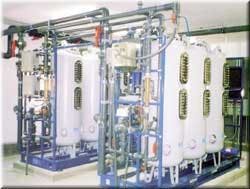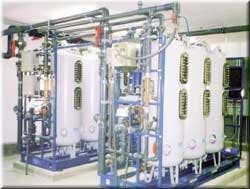New Treatment Systems May Ease Arsenic Compliance
By T. David Chinn
Having been actively discussed for over 10 years by epidemiologists, scientists, water engineers, politicians and even late-night talk show hosts, the debate surrounding the Environmental Protection Agency's new Arsenic Rule has - for the most part - concluded.
The new standard calls for a Maximum Contaminant Level (MCL) of 10 ppb, with a compliance date of February 2006. The majority of the water systems that must comply with the Arsenic Rule rely upon ground water.
At the MCL of 10 ppb, the EPA estimates that about 5.5 percent or nearly 3,000 of the nation's 54,000 community water systems will need to take measures to lower arsenic in their drinking water. Of the affected systems, 94 percent serve less than 10,000 people.
Complying with the Mandate
The first step to complying with the Arsenic Rule will be to conduct a comprehensive water quality sampling program. For many water systems, the raw water arsenic concentrations will vary throughout the year in response to changes in water quality, well operations and the water table. These seasonal changes may lend themselves to certain treatment processes or allow for effective implementation of non-treatment alternatives. These non-treatment strategies include:
•Blending wells prior to distribution;
•Well screen modifications (e.g., sealing off high arsenic production zones); and
•Well abandonment and construction of new wells.
Where non-treatment alternatives are insufficient or impractical, arsenic removal will be required. Several treatment alternatives are available, ranging from the modification of existing treatment processes to point-of-use, reverse osmosis systems.
Modification of existing treatment processes will primarily be applicable for conventional surface water treatment facilities, while point-of-use and point-of-entry systems might be viable alternatives for extremely small public water systems. The majority of water systems, particularly ground water systems in the 50 to 1,500 gpm range, will implement one of three technologies:
•Adsorption;
•Ion Exchange; or
•Coagulation /Filtration
Well-Head Treatment Technologies
The EPA lists several treatment processes as "best available technologies" (BAT) for arsenic removal. In the past, activated alumina was a commonly used adsorbent for arsenic removal. However, this technology can include complex (and expensive) pH adjustment and regenerating systems. For example, optimum removal of arsenic with activated alumina occurs around pH 6, with the media life decreasing by half at pH 8. In addition, arsenite [As (III)] is not removed as well by activated alumina as the oxidized form of arsenic, arsenate [As(V)]. Regeneration of the media involves using significant quantities of strong acids and bases, an operational factor that must be considered.
The ion exchange process is similar in many ways to activated alumina. However, column runs tend to be shorter while regeneration is done with a strong salt solution rather than strong acids and bases. As with activated alumina, arsenic must be present as As(V) to be removed by the ion exchange resins. Since sulfate competes with arsenic for binding sites on the ion exchange resin, the practicality of the process is limited to systems where the sulfate concentration in the raw water is less than 250 mg/l (ppm). In addition, the process generates a large quantity of brine that must be properly disposed. The American Waterworks Association Research Foundation (AWWA/RF) is currently investigating new ion exchange processes that limit the quantity of residuals to overcome this shortcoming.
Ion exchange columns can achieve 95%+ removal of arsenic but may be too complex for single wellhead operations.
The use of coagulants followed by either pressure filtration or membrane filters also are viable processes. They involve the addition of ferric chloride to the raw water followed by a short mixing step to bind the arsenic to the ferrihydrite precipitates that form. These precipitates are then removed by low-pressure granular filters or low-pressure membranes (frequently microfiltration units, although ultrafiltration units also have been used.) This process can be water efficient and generates only small quantities of ferrihydrite residuals for disposal. However, equipment costs are expected to be higher than sorption technologies, especially for smaller systems.
Specialty Sorbents
A tremendous amount of research and development of specialty sorbents for arsenic removal has been conducted within the past five years. A number of iron- and aluminum-based adsorbents have been developed in the past few years to overcome the shortcomings of the traditional treatment techniques.
These "designer adsorbents" have several distinct advantages over the older technologies. First, they have been formulated to preferentially adsorb arsenic ions as opposed to a range of constituents such as sulfates and nitrates that could compete for the adsorption sites (and prematurely exhaust the media). Second, some are meant to be disposable media and simply discarded into a landfill as opposed to regenerated on-site by the utility. A fresh column of media can then be placed into service.
Treatment Cost Estimates
Regardless of the technology chosen, the cost of arsenic removal is significant - both in initial capital costs as well as ongoing operational and maintenance (O&M) costs. For example, the projected capital costs of a 1-mgd (700 gpm) well can range from $0.75 to $1.50 per gallon, depending upon the process and raw water quality. Land acquisition, if needed, may further increase this cost. Annual O&M costs are forecast to be $100,000-$180,000 for a 1-mgd facility. For a 0.1 mgd (70 gpm) facility, capital costs will be approximately $75,000-$150,000 with annual O&M costs in the $15,000-$30,000 range.
About the Author:
T. David (Tim) Chinn is a Vice President and National Director for Potable Water with HDR, a firm providing architecture, engineering, consulting and project development services. HDR's Water Program is ranked as one of the Top 10 in the nation by Engineering News Record (ENR.) Chinn is intimately familiar with the Arsenic Rule, having chaired the American Water Work Association's (AWWA) Arsenic Task Force since its inception in 1992. He is nationally recognized in water issues and has testified before numerous Congressional and US EPA Panels concerning the regulation of water supplies.


